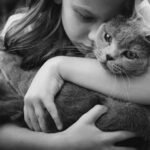Cats have a reputation for being mysterious and independent, but beneath their cool exteriors, many are quietly weaving deep emotional bonds with their humans. Have you ever wondered if your cat is doing more than just tolerating you? The truth is, cats often establish heartfelt routines with those they trust, sometimes in subtle, surprising ways. These routines aren’t just cute quirks—they’re a sign your feline friend is building a rhythm of affection, connection, and comfort with you. Let’s explore the telltale signs your cat is creating an emotional routine, and discover how these little gestures can mean so much.
Your Cat Greets You at the Door

One of the most heartwarming moments for any cat owner is arriving home to a furry welcome committee. If your cat races to the door when you return, it’s not just coincidence. This behavior shows your cat eagerly anticipates your arrival, making it a ritual to reconnect with you. Over time, this greeting becomes a daily highlight for both you and your feline companion, strengthening your bond. Cats who do this often have a keen sense of your schedule, even waiting by the door at the usual time you return. It’s as if they are saying, “I missed you!” This display of affection is a clear signal that your cat has woven you into its daily emotional routine. The excitement in their eyes or the gentle rub against your legs is their way of welcoming you home.
Following You Around the House

If you find your cat trailing behind you from room to room, it’s not just curiosity—it’s companionship. Cats that follow their humans are showing a desire to be close, even if they’re not seeking constant attention. This behavior is a strong indicator your cat feels safe and content by your side. It’s their version of “together time,” a sign you’re an important part of their world. Even if they simply perch nearby while you work or relax, their presence is intentional. Some cats make it a point to nap in the same room you’re in, subtly syncing their routine with yours. This gentle shadowing is a loving, habitual gesture, reinforcing your bond with every step.
Initiating Play at Specific Times

Cats love routine, and many establish specific playtimes with their favorite humans. If your cat brings you their favorite toy at the same time each day or pounces around expectantly, they’re inviting you into their playful ritual. This consistency is more than just boredom—it’s an emotional routine created just for you. Playtime becomes a shared event, strengthening trust and communication. You might notice your cat gets energetic around your lunch break or in the evening, learning your patterns and syncing their play to your schedule. These moments are treasured bonding opportunities, full of laughter, movement, and connection. When your cat expects—and waits—for these play sessions, it’s a sure sign you’re a central figure in their emotional life.
Morning and Nighttime Rituals

Does your cat wake you up with gentle purrs or nestle beside you as you wind down at night? These morning and nighttime routines are some of the strongest signs of an emotional connection. Cats who greet the day with you or help tuck you in at night are making you part of their daily cycle. These rituals often become non-negotiable for your cat—they might even protest if the routine is broken. Morning head bumps, nighttime cuddles, or simply being there as you start and end your day is their way of saying, “We’re in this together.” These moments bookend your day with affection, making your cat a consistent source of comfort and stability.
Purring and Kneading When You’re Near

Purring is one of the most soothing sounds a cat can make, and when paired with kneading—those rhythmic paw presses—it’s a sure sign of contentment and trust. If your cat regularly purrs and kneads when you’re nearby, they’re expressing deep affection and reinforcing their bond with you. This behavior often becomes part of a routine, like during your quiet time in the evening or when you sit in your favorite chair. It’s as if your cat is saying, “You make me feel safe and happy.” The combination of purring and kneading is a powerful, tactile way cats show their love, making you an essential part of their emotional landscape.
Bringing You “Gifts”

While it might not always be pleasant, a cat that brings you “gifts”—from toys to less savory surprises like bugs—is showing a unique kind of affection. This behavior is rooted in their instincts, but it also signals that your cat sees you as family. Over time, gifting can become a quirky routine, especially if your cat presents treasures at the same time or place each day. It’s their way of sharing what they value, even if it’s not always what you’d choose. Accepting these gifts, with a grateful heart (and maybe a discreet disposal), is a way to acknowledge your cat’s emotional investment. This sharing ritual is a fascinating window into your cat’s sense of connection and care.
Vocalizing in Response to Your Voice

Cats are often more vocal with the people they trust. If your cat meows, chirps, or trills in response to your voice, they’re engaging in a special kind of conversation. Over time, these vocal exchanges can become a cherished routine. You might notice your cat answers when you call their name, or they initiate a “chat” at certain times each day. This back-and-forth is a sign your cat is emotionally tuned in to you, using their voice to connect and communicate. It’s almost like having your own secret language, a daily ritual that only the two of you share. These vocal routines deepen your relationship and keep you closely connected.
Seeking Out Your Lap or Physical Touch

When your cat regularly seeks out your lap or leans into your touch, they’re not just looking for warmth—they’re craving closeness. Cats that make a habit of curling up with you are making you part of their comfort routine. This physical closeness is a sign of deep trust, as cats are most vulnerable when they’re relaxed and cuddled up. Whether it’s during your morning coffee or your favorite TV show, this routine reinforces your bond day after day. Over time, your cat may even expect these cuddles, waiting patiently for their special moment with you. This simple act of togetherness is a daily reminder of the emotional connection you share.
Mirroring Your Behaviors and Schedule

Some cats go beyond following you—they actually mirror your behaviors and schedule. If your cat wakes up when you do, eats when you eat, or settles down when you’re winding down, it’s a strong sign they’ve adapted their routine to yours. This synchronization is a powerful indicator of emotional attachment. Your cat is essentially saying, “Your rhythm is my rhythm.” Over time, this mirroring can feel almost uncanny, as if your cat knows exactly what you’re about to do. These shared routines make life with a cat feel deeply interconnected, turning everyday moments into a shared experience.
Displaying Signs of Separation Anxiety

When your cat shows signs of distress when you leave—such as vocalizing, pacing, or waiting by the door—it’s clear you’ve become part of their emotional routine. Separation anxiety isn’t just about missing you; it shows your cat relies on your presence for comfort and stability. Over time, you might notice certain behaviors become more pronounced if your schedule changes or you’re away longer than usual. While it’s important to help your cat adjust, this attachment is a testament to the emotional bond you’ve built together. Your cat’s anxiety at your absence highlights just how significant you are in their daily life, turning ordinary routines into sources of reassurance and connection.

Growing up traveling and experiencing new cultures and wonders, I have had a passion for nature, adventuring, photography, and videography. I am currently working towards a BSc in Biodiversity and Ecology at Stellenbosch University, and I hope to specialise in Marine Sciences one day.
Please send any feedback to Feedback@animalsaroundtheglobe.com






